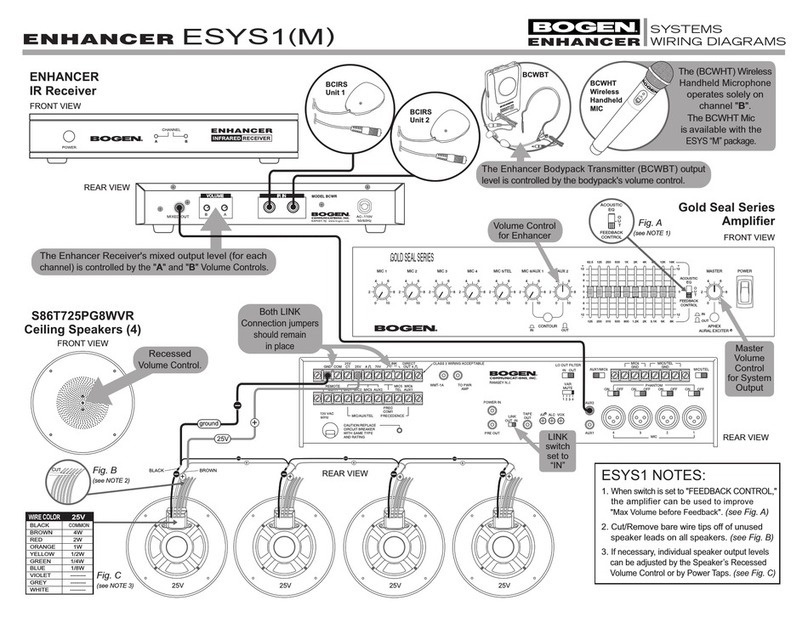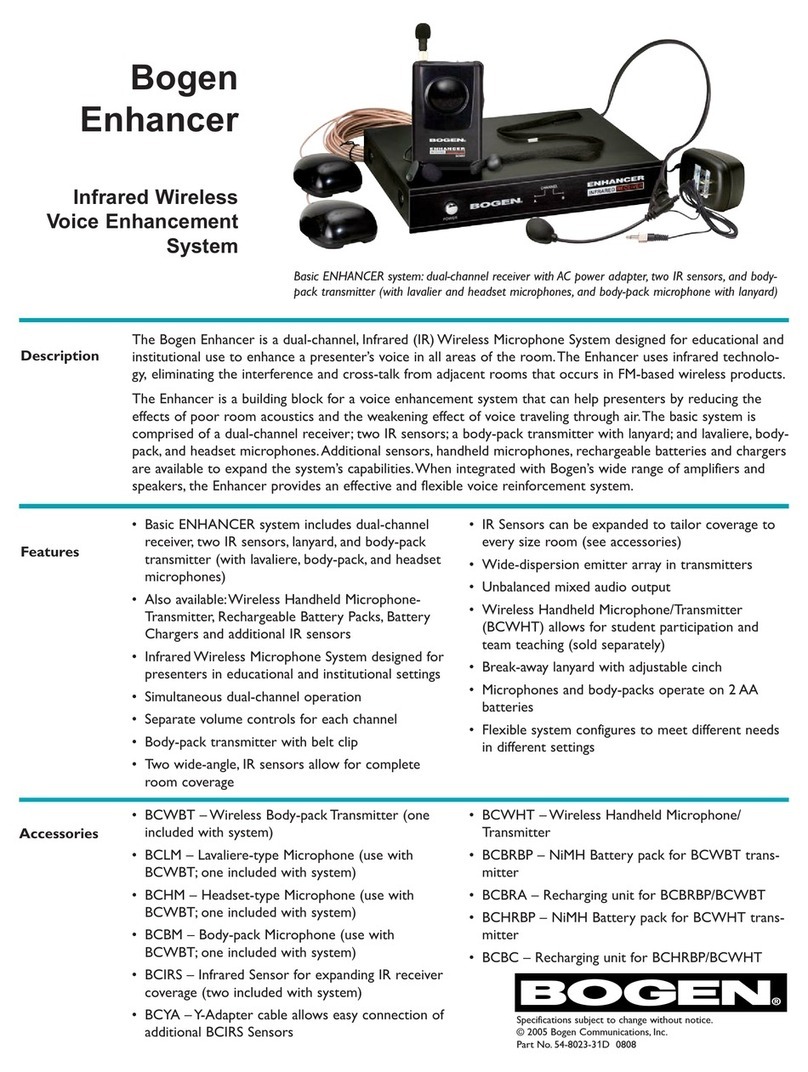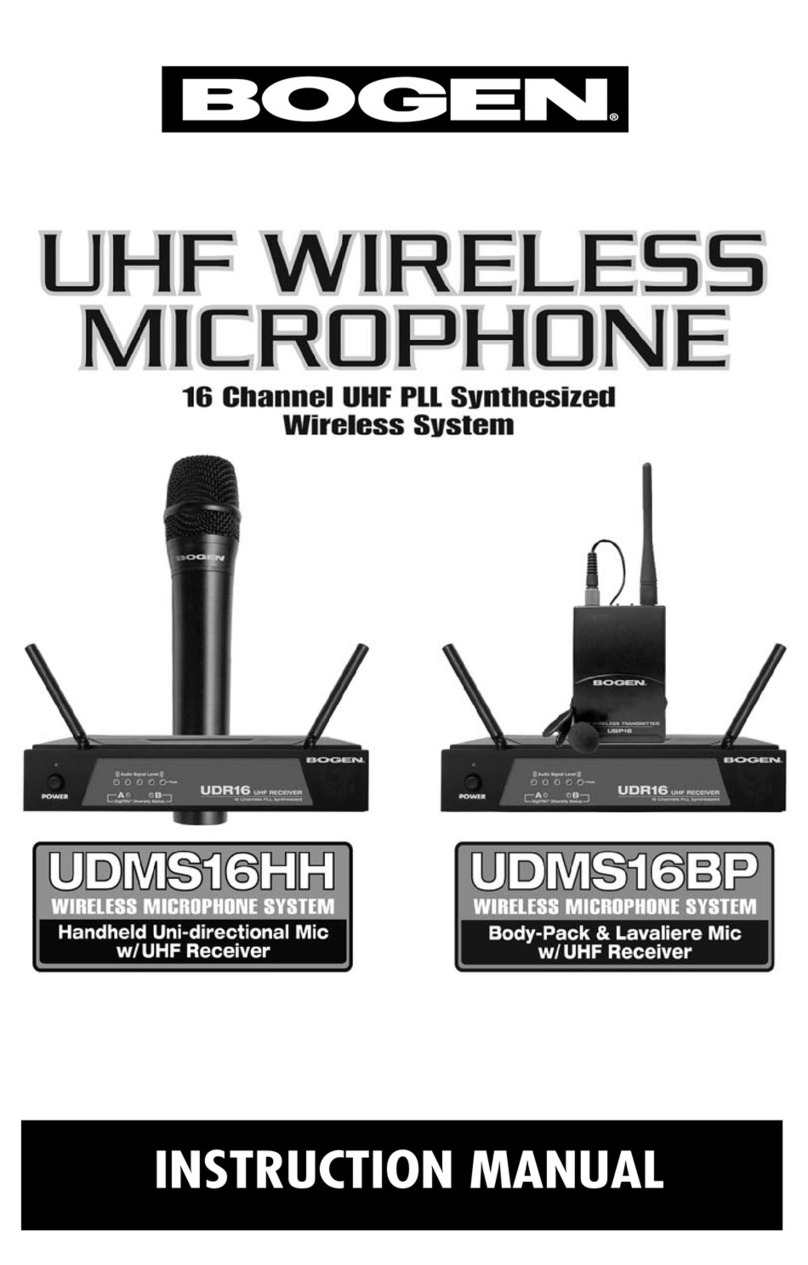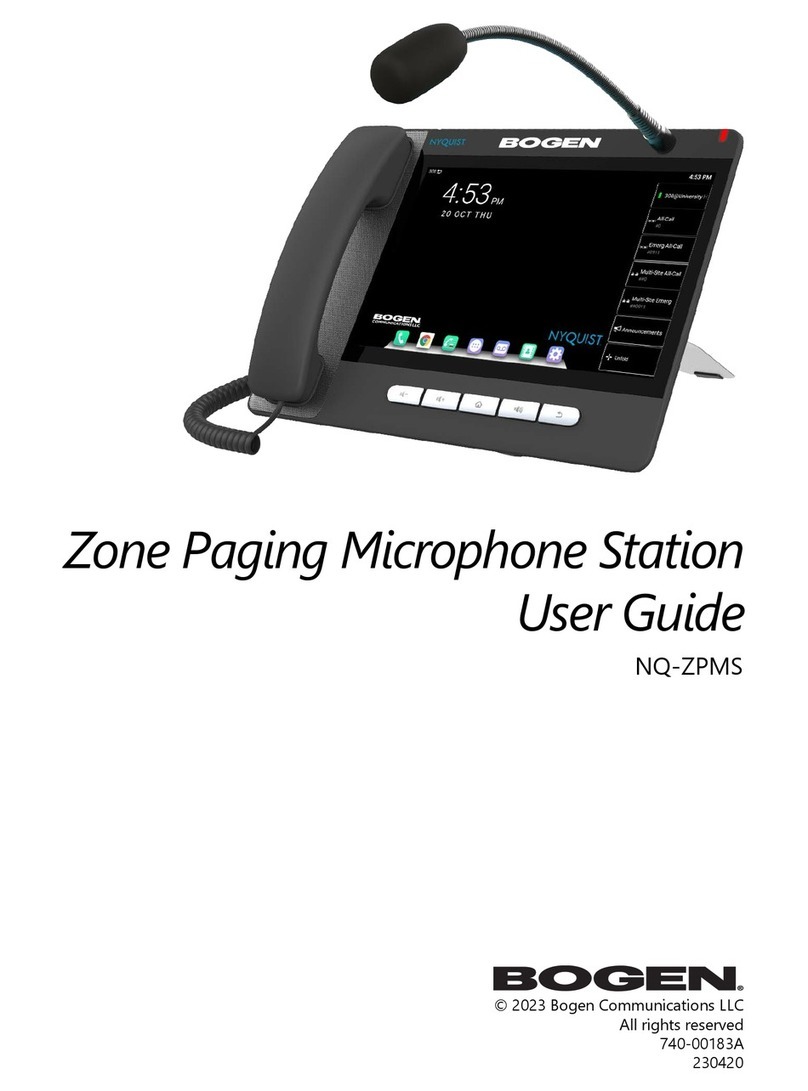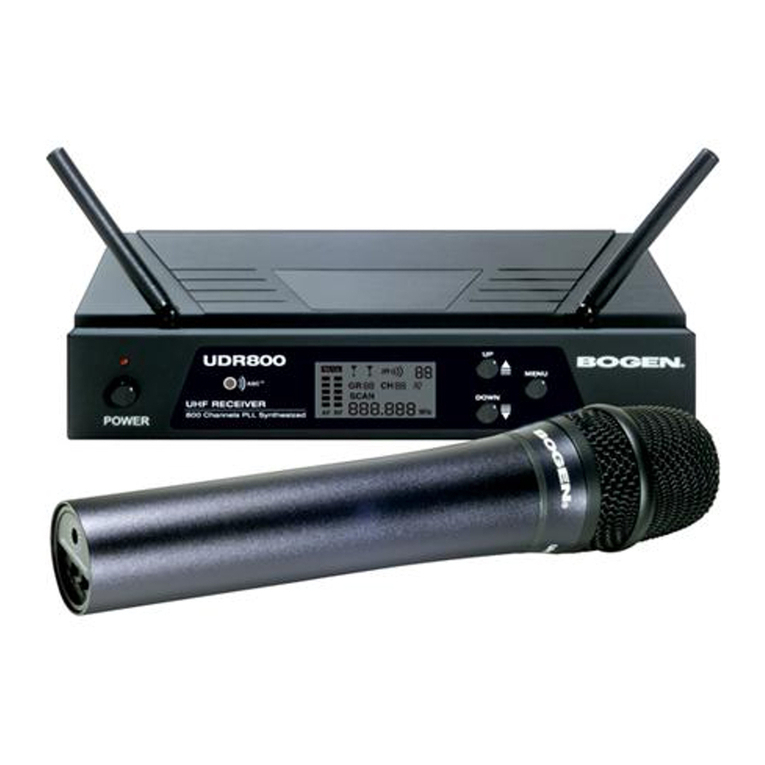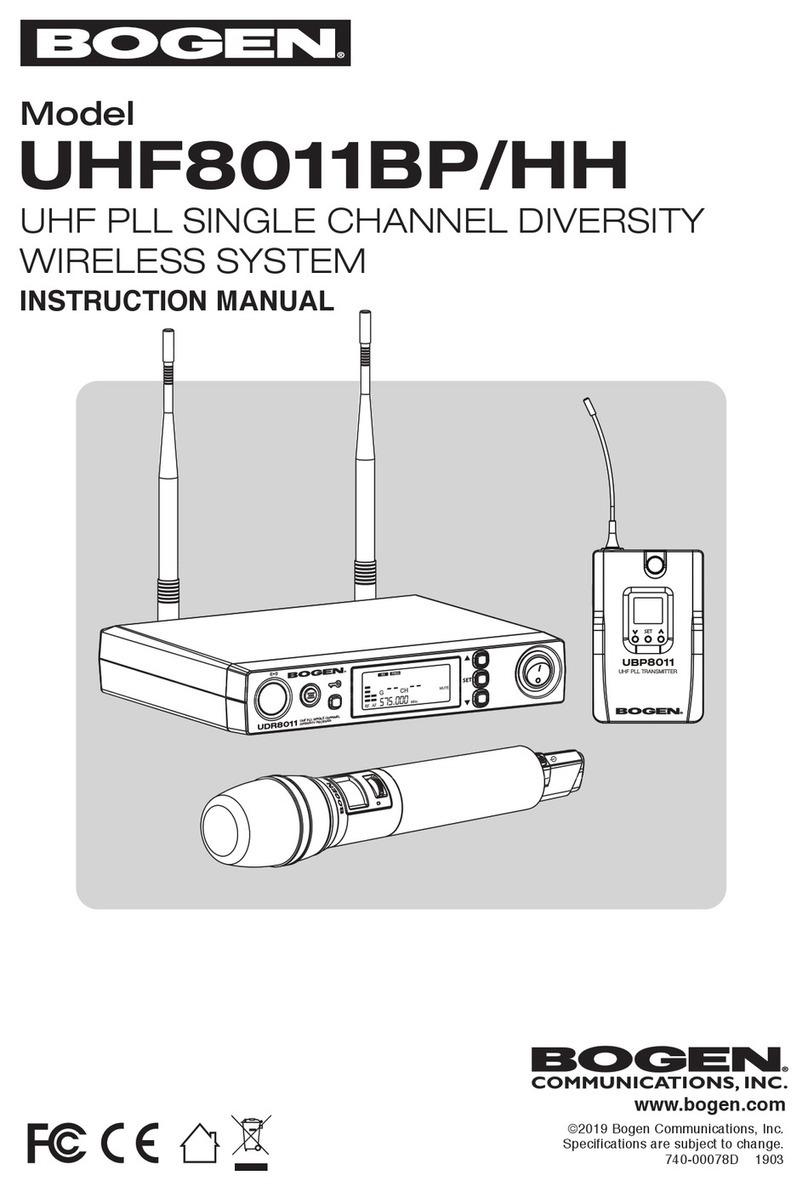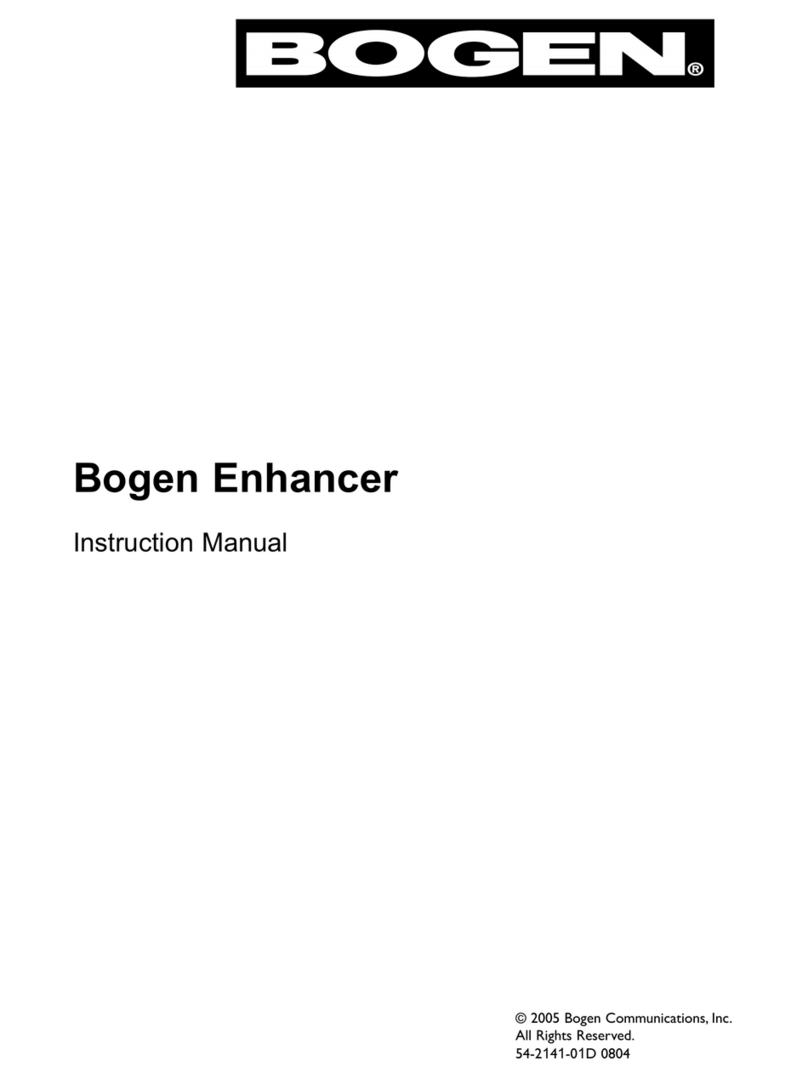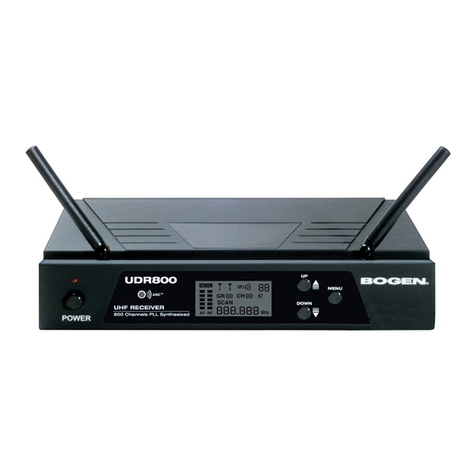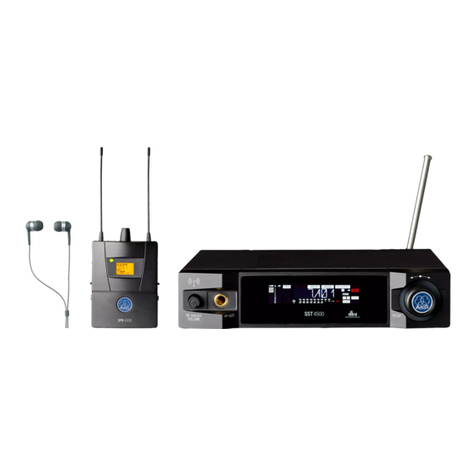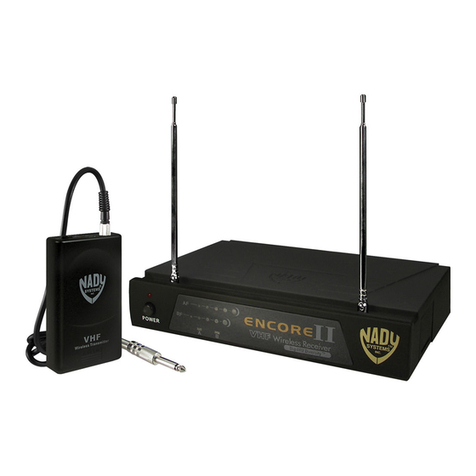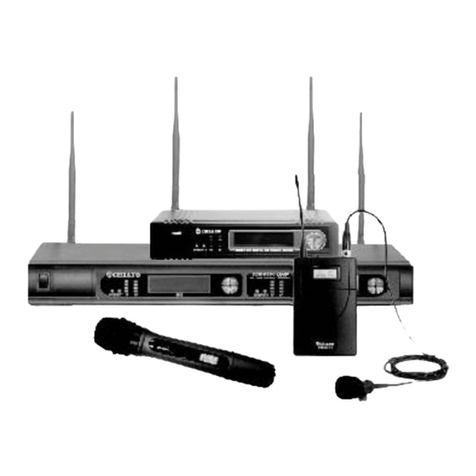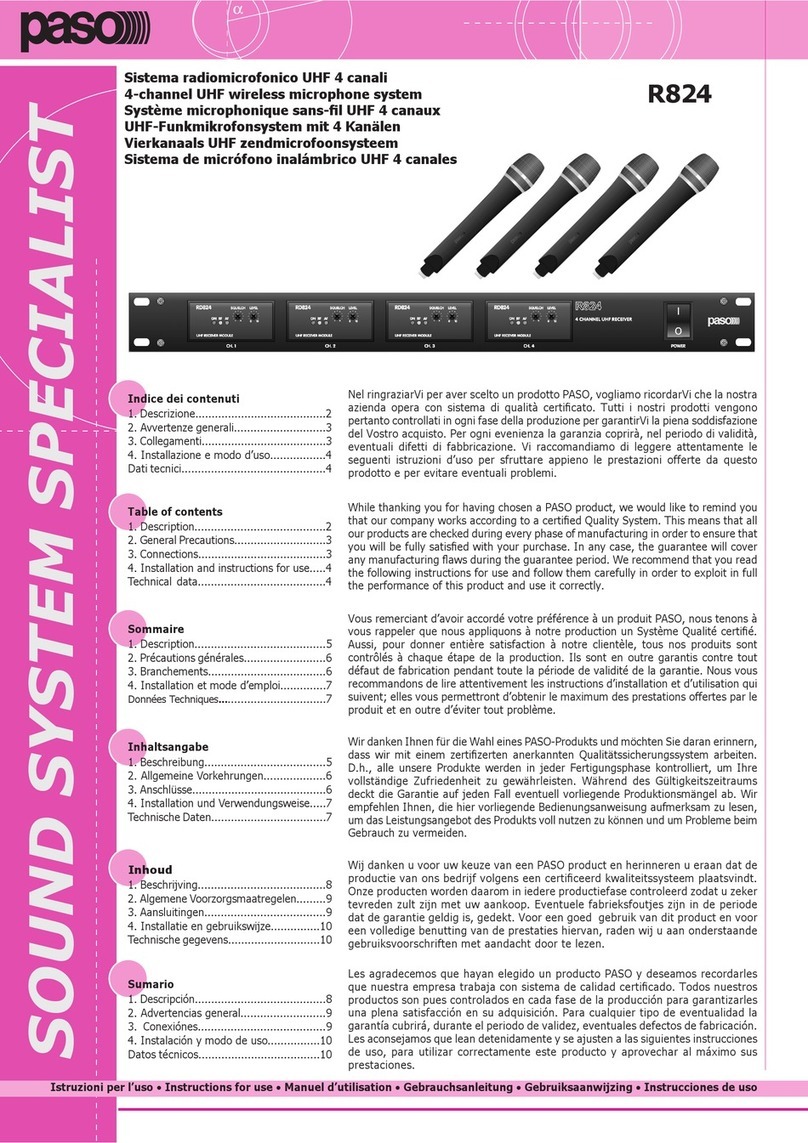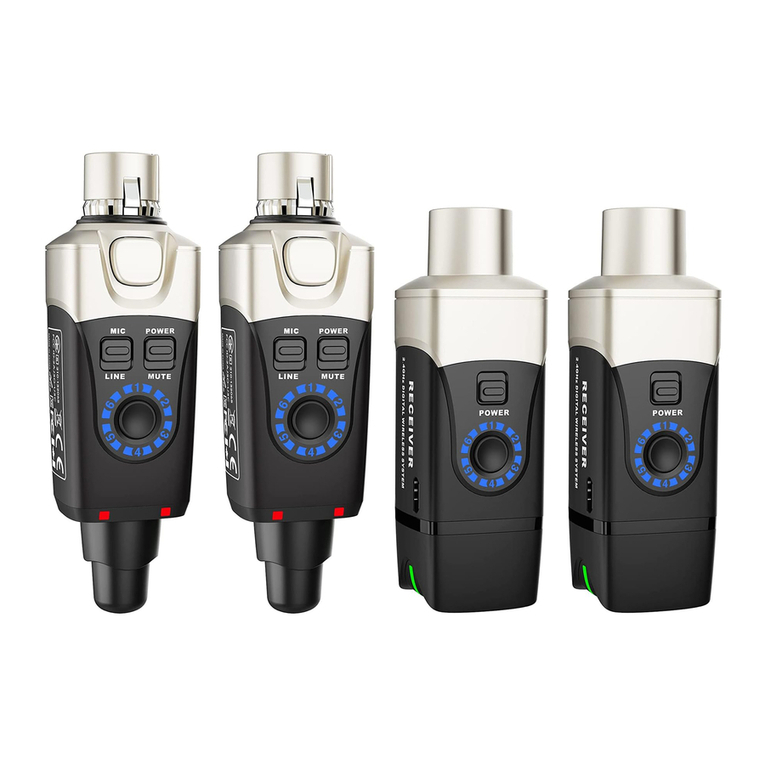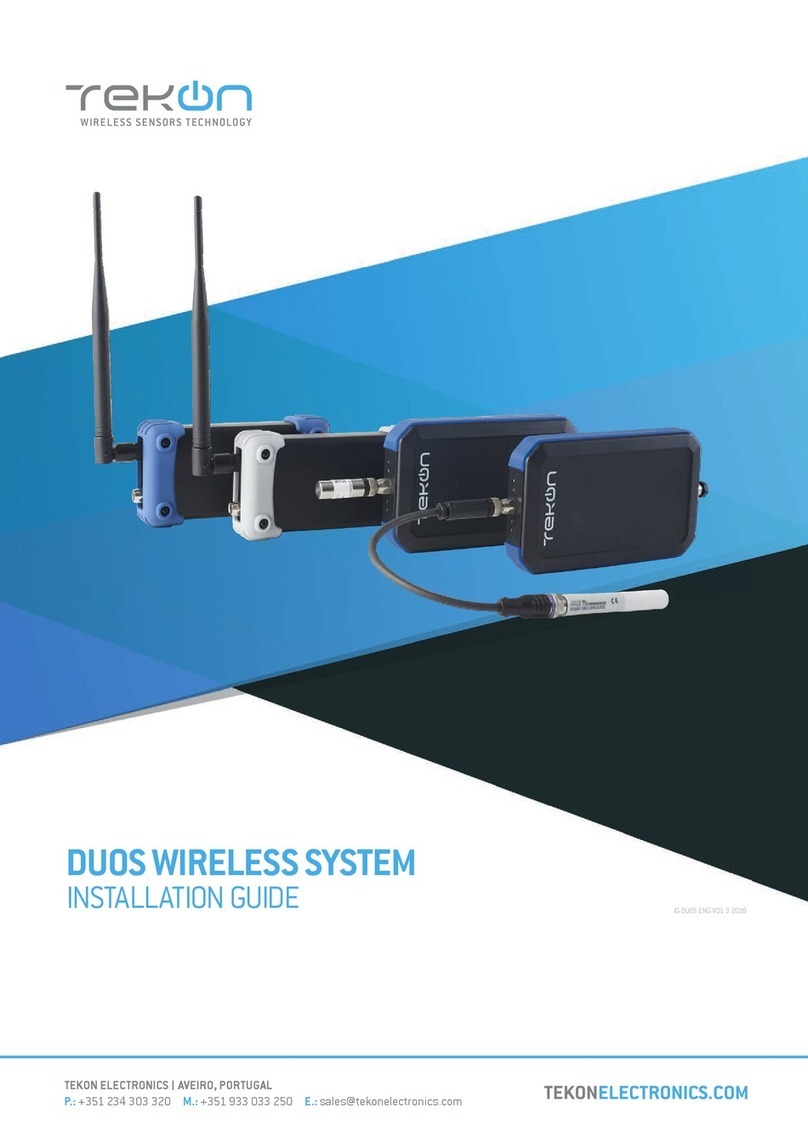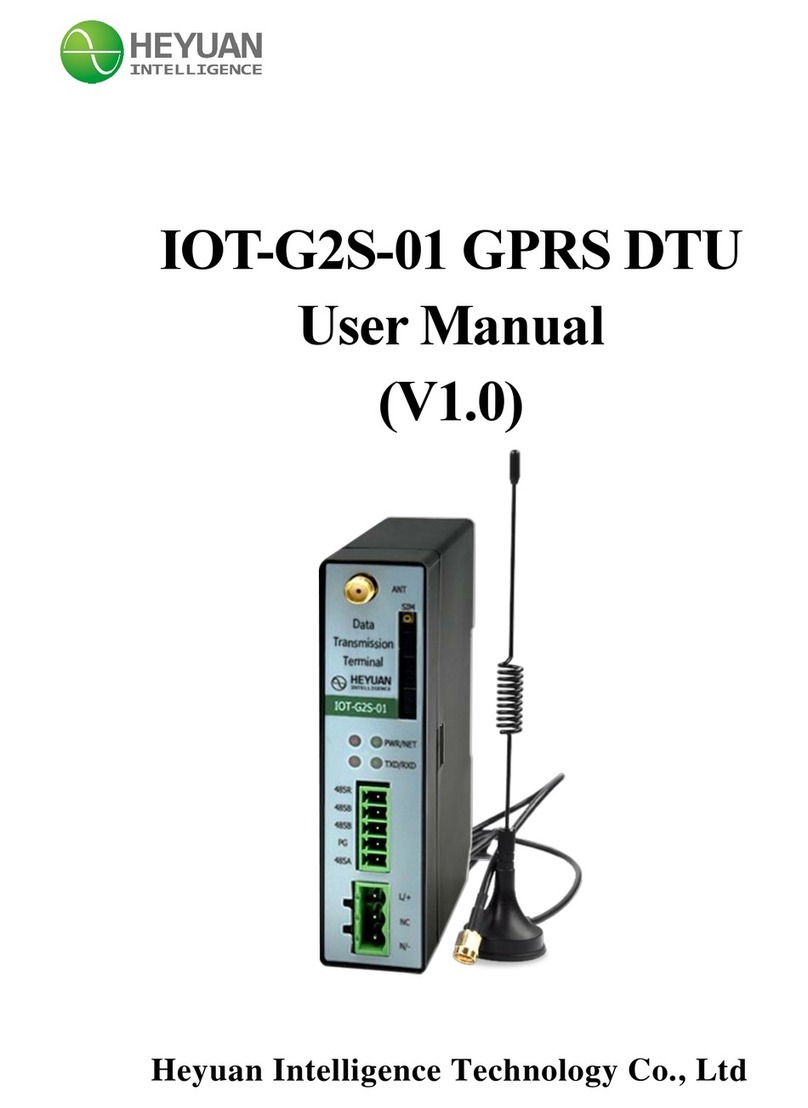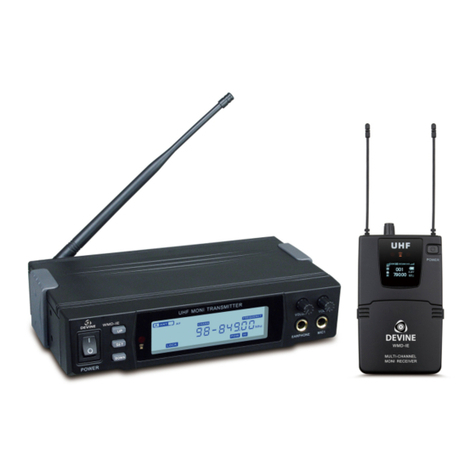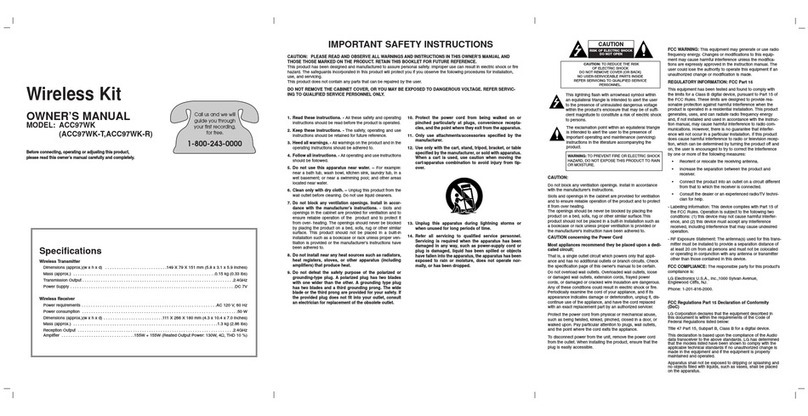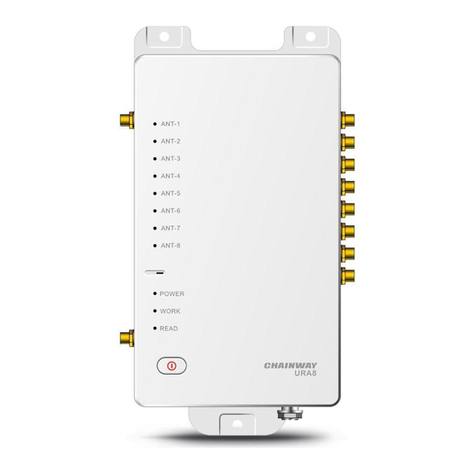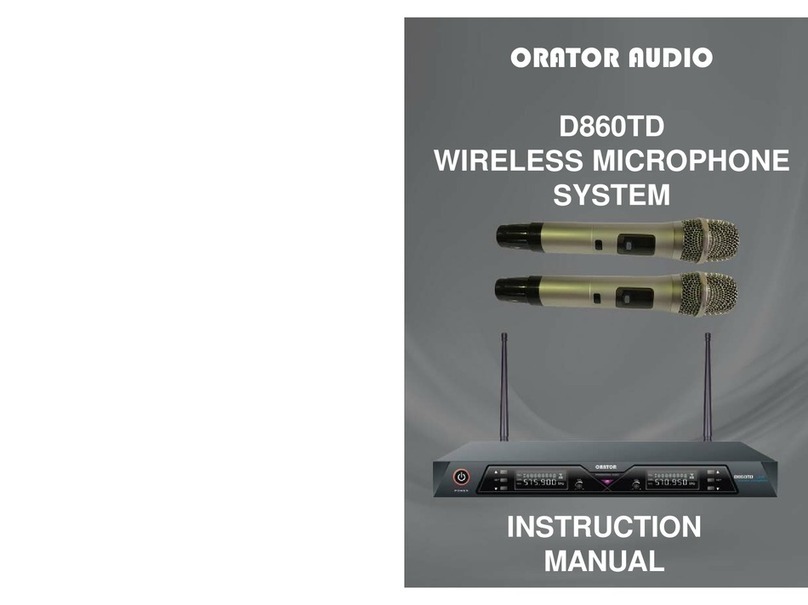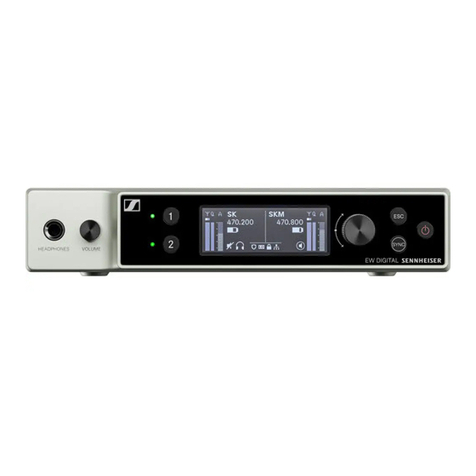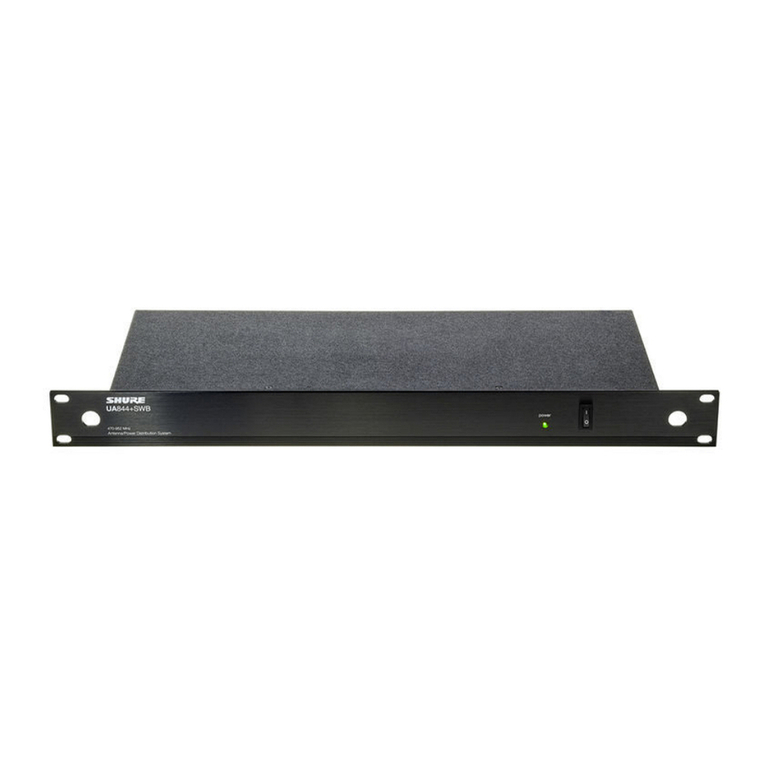Listening Is Key to Learning
Being able to listen is essential for learning. This is par-
ticularly critical in the classroom where students are
dependent upon speech communications
60% of the day.1
Yet classrooms, whether open or traditional layout,
typically
have poor acoustical qualities as well as back-
ground noise.
Bogen's Enhancer system improves the level of the
teacher's voice or sound source and delivers it naturally,
clearly, and equally to all areas of the classroom so that
each student hears the teacher as if they were sitting at the
front of the class.
Teaching:
Getting Your Point Across
Students in the back of the classroom have more difficulty
listening to the teacher because sound diminishes over
distance. Thus those furthest away from the teacher hear
the teacher’s voice at a lower level than those sitting up
front. This puts them at an educational disadvantage.
Background noise, ineffective soundproofing treatment,
and mild hearing loss due to ear infections are addi-
tional reasons why children have difficulty hearing in
the classroom.
"Hearing a teacher's voice at only half or a quarter of nor-
mal sound can cause students to misinterpret lessons and
misunderstand directions. Kids who strain to hear tend to
tire quickly, lose their concentration, and disengage from
classroom lessons and activities."
2
Why Noise Treatments Fail
Effective treatment of noise pollution in classrooms is not
always possible. The root cause of many noise problems is
inherent in the structure of the facility which, in many
cases, was constructed at a time when there was less out-
door noise from fewer cars and aircraft, and before com-
puters and air conditioning were included in the class-
room. Some schools have resorted to sound absorption
treatments or noise-masking techniques but these meas-
ures do not address the level of a teacher's voice and often
negatively impact its intelligibility and understanding.
What Are Your Students Hearing?
1. The American National Standard Institute ANSI S12.60-2002
2. "Can You Hear Me Now?" by Susan Black, American School
Board Journal, May 2003
Teachers who use Classroom Amplification
Systems Report:
•Increased student participation, attentiveness, and focus
•Reduced need to maintain discipline as students are better
able to remain on task
•Better student performance
•Reduced need to repeat instructions, and ability
to cover more of the curriculum
•Increased comprehension of verbal directions
•Reduced distractions from ambient
and background noise
•Decreased teacher fatigue, vocal stress,
and absenteeism
Bogen Enhancer:
The Sound Solution for Every Classroom
Bogen Enhancer Systems use wireless, infrared technology
to transmit the speaker's voice from the microphone to a
receiving unit. The system then amplifies the audio and
delivers it to strategically positioned audio speakers
installed in the ceiling or on the walls. A/V equipment
such as projectors, televisions, or computers can also be
connected to the Bogen Enhancer system to ensure the
clear and equal transmission of audio throughout the
classroom.
The Enhancer system puts no demand on the teacher
since it is easy to use and takes up little space in the
classroom. In addition, technology has become so com-
mon in today's culture that children readily accept
audio amplification in the classroom and do not con-
sider it intrusive. In fact, students seem to participate
more readily as they are eager for an opportunity to
use the microphone.
Sound In Today’s Classrooms
Bogen Enhancer audio amplification systems can be
easily installed in new building construction as well as
to retrofit existing schools. It works equally well in tra-
ditional or open classroom environments.
With the
Enhancer’s flexible design, any application or physical
environment can be addressed with a single system
solution from Bogen.
More and more schools are using audio amplification
systems in their classrooms in an effort to ensure that
teachers are easily heard. Two pieces of legislation man-
dating the use of these systems have already passed.
Ohio has mandated that new school construction, as
well as rooms used by special needs students, have
audio amplification. In Orange County, Florida, all class-
rooms for K-12 students require audio amplification.
Classroom & Outside Background Noise
Sources of background noise include adjacent classrooms,
hallway noise, activity in schoolyards and stadiums,
grounds maintenance, building construction, roof-mounted
machinery and equipment, vehicle traffic and parking
areas, HVAC systems, and nearby highways or airports.
Noise within classrooms include wind noise from air condi-
tioners and ventilation, rumbling heaters, the hum of com-
puter fans, ticking of analog clocks, chatty students, squeaky
desks, light fixtures, and noise from A/V equipment.
Trying to combat background noise can be expensive and is
not always effective. On the other hand, it is much less
expensive and easier to distribute the teacher's voice at the
same level to all parts of the classroom. This way, students
sitting in the rear of the room or in areas where back-
ground noise is most distracting can hear the teacher as if
they were at the head of the class.
Noise Competition:
Contending with Many Sources
A teacher's most critical instructional tool is his or her
voice. In order to be heard, teachers must raise their
voices to combat offending noise pollution. However,
this constant voice projection can lead to educator
fatigue, vocal strain, hoarseness, laryngitis, or chronic
voice problems.
When using the Bogen Enhancer, teachers speak at their
natural projected voice level (about 67 dB) and students
in all parts of the classroom can hear at that same level.
Plus, the teacher has freedom of movement and can
even face the chalkboard while speaking without any
drop in voice level for any student. When using the
Bogen Enhancer the teacher may speak at a natural sound
level (without projecting), allowing the Enhancer system
to increase the sound level as needed so the students
can easily hear.
Physics dictates how sound dissipates over distance. When there is a single point of origin of a sound source, such
as when a teacher speaks, sound decreases following the inverse square law. This causes sound levels to drop ever
more rapidly with increasing distance. For each decrease of 10 dB, sound intensity is cut in half. Thus a 57 dB level
sounds half as loud as a 67 dB level, and a 47 dB level is half as loud as a 57 dB level. The only way to combat this
sound dissipation in a classroom is to electronically reinforce the sound source using amplifiers and speakers.
Intelligibility:
The Finer Points of Language
Classroom audio amplification systems increase speech
perception for both normal hearing and hearing disadvan-
taged students. Students need to hear clearly articulat-
ed letter and word sounds so they can learn new words,
decipher letters for spelling, and comprehend verbal
instruction. In addition, sound is diminished when
teachers speak facing the chalkboard, move around the
classroom, or when students answer from their seats.
Distribute Sound Evenly Throughout The Classroom
Typical classroom in which
the students sitting in the
rear of the class hear
only 25% of what the
teacher says.
Body-Pack
Transmitter
Lavaliere
Microphone
Body-Pack
Lanyard
Handheld Microphone
Transmitter
Body-Pack
Microphone
Headset
Microphone
Enhancer
Receiver
Unit
With the Bogen Enhancer,
students sitting at the
back of the class hear
just as well as those
sitting up front.
The evidence for improved teaching and quality of instruction
is reflected in the statistically significant gains in reading and
language achievement test scores for K-6 students included
in classrooms using amplification (students with and without
hearing loss). These improvements were evident after only
one year of use...
("The Use of Sound Field Amplification of the Teacher's Voice In The
Regular Education Classroom, A Summary of Studies",
The MARRS Project: Mainstream Amplification Resource Room Study, 1999)
Poor acoustics often caused by hard-surfaced floors and noise from heating and air conditioning
systems, as well as additional ambient noise, reduce speech intelligibility to less than 75 percent
in most classrooms.... Students in classes where teachers wear mikes are likely to achieve a
minimum 10 percent overall gain in standardized test scores, especially in subjects relying
heavily on verbal instruction.
("Speaking Up" by Susan McLester, "Technology & Learning" Magazine, November 2004)
A Decrease of 10 dB
= 50% Sound Loss
